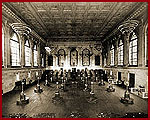
The consequences of World War I in the European societies and economies were devastating. 7% of the most productive workforce in West Europe withdrew definitively from the production process. Seven years after the end of the war, the per capita income of Britain, France and Germany appeared smaller than in 1913. Until 1928, the level of agricultural production in France and Germany was lower than prewar levels. It is estimated that the industrial production of Europe had delayed eight years, until it was able to reach its prewar growth rates. In addition, the division of empires into many new sovereignties reduced trade and transactions movement.
The state's interventionist role in economy and mainly the effort to administer  resources during the war, aimed at the success of the war endeavour. However, the same policy continued after its termination too. The restructure, reconstruction and handling of economic instability aimed at the "re-nationalisation" of eastern economies. Two big economic crises undermined the parliamentary democracies and promoted the emergence of authoritarian regimes. An important problem of the interwar years was the constantly increasing inflation. The rapid rise in prices after 1918 was due to the large deficits brought about by the war. Between 1920 and 1923 the Deutschmark was devalued to such an extent, that transactions were often effected through product exchanges. resources during the war, aimed at the success of the war endeavour. However, the same policy continued after its termination too. The restructure, reconstruction and handling of economic instability aimed at the "re-nationalisation" of eastern economies. Two big economic crises undermined the parliamentary democracies and promoted the emergence of authoritarian regimes. An important problem of the interwar years was the constantly increasing inflation. The rapid rise in prices after 1918 was due to the large deficits brought about by the war. Between 1920 and 1923 the Deutschmark was devalued to such an extent, that transactions were often effected through product exchanges.
The U.S.A. became the major creditor of European economies and the most important source of investment capitals. They lended Germany so that it could pay war reparations to France and Great Britain, while these two countries payed to America the interests of their war loans. In this way, while in the 1920s Britain experienced unemployment and decline in production, the U.S.A. enjoyed an unprecedented economic growth. However, this rapid growth bore the seeds of slump.
From 1925 to 1930 Europe seemed to regain its prewar economic level, as the volume of trade and production was increasing. What existed behind this optimistic facade was the problem of fall in the prices of agricultural products. The farmers' efforts to redress their income by increasing production, brought about the creation of large reserves in wheat, coffee, sugar and other agricultural products, many among which came from Third World countries. The result of increased production was the constant fall in the prices of these products. The fall of agricultural income directly affected the market of industrial goods as well. The major economic crisis had already begun. |


